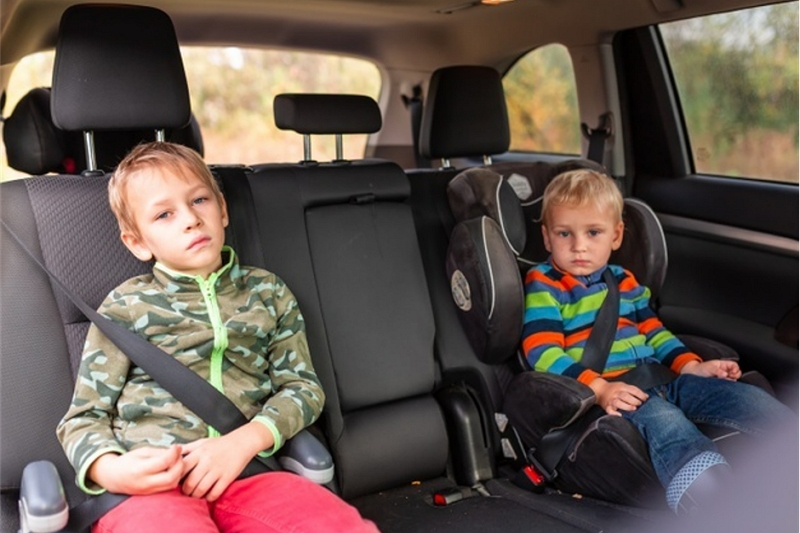When to change car seats for toddler? When your child outgrows the height or weight limits of their car seat. The details on when to move up will depend on which type you have but can range anywhere from age two (when children are about 50 pounds) all the way through six years old (the upper end is 35 pounds).
Check your manual for specifics. You want them snug enough that they aren’t slipping around in it and there’s less than an inch of movement at the head between where it touches her shoulders and where her head rests against the top edge.

If the child slouches forward so much that he/she seems uncomfortable, tighten it more until the child sits upright with good posture without being too tight. If the child leans back so far that his/her head is touching the top edge, loosen it until the child’s sitting upright.
If you have a seat with two harness slots in the back of the seat (the middle one makes them sit up straighter), put your child in that slot when they are seated so their shoulders and hips are at even height on each side.
When using this position for long periods, make sure to check how she looks from behind once or twice during stops to be certain her head isn’t leaning too far forward against the strap which could damage her spine over time if she falls asleep like that often.
What is the weight requirement for a booster seat in California?
A booster seat is a special car safety harness that helps children travel more safely. It raises the child so an adult seat belt fits correctly on them, which prevents injury in case of accidents or sudden stops. Booster seats are not required by law for all ages and sizes of children.
In California, a child must be at least 40 pounds before he or she can ride in a booster seat.
The law requires the following:
* When a child is younger than two years old.
* While travelling through air that is not pressurized if your child weighs 40 to 80 pounds and will be riding on an aeroplane for more than one hour.
What are the height and weight requirements for a backless booster seat?
A backless booster seat is used to help position the vehicle’s safety belt appropriately. These seats are intended for older children who weigh between 40 and 80 pounds, or when your child has grown too tall for their forward-facing car seat but not yet reached the weight requirements of a regular adult lap/shoulder belt.
Backless boosters place both shoulder belts on your child; one across his chest and another at his hips (like with padding). These types of seats must support your growing child correctly so they don’t slouch while sitting – this can result in injury during collisions.
There aren’t specific height and weight standards enforced by law, however, it varies based upon the company making the product. For example, the Britax Parkway SG is designed for children weighing between 30 and 100 pounds.
It’s important to note that a backless booster seat should only be used when your child has outgrown their forward-facing car seat with a harness system.
Are high back boosters safer than backless?
A high back booster can provide more protection than a backless one because it covers the entire seat.
This is especially useful in case of side collisions, where torso support may be needed to help prevent whiplash or other chest injuries. High-back boosters are also preferred for children who have outgrown their harnessed car seats but still need additional positioning and safety features like headrests and armrests.
According to Car Safety Seat Standards from NHTSA (National Highway Traffic Safety Administration), “some vehicle manufacturers will only certify an infant restraint if that model has both low-back style restraints as well as high-back style restraints .”
The reason this matter comes into play when trying to fit multiple car seats across your back seat.
Backless car seats usually do not have the same type of side wings or head support that high-backed models provide, which can be problematic in many types of crashes when it comes to protecting your child’s neck and spine.
Some backless booster options are equipped with a harness system but these are much less common than harnessed convertible car seats. If you decide to go with this option make sure it is approved for use without a vehicle’s own lap/shoulder belt because there are no safety standards for boosters used only with an adult seatbelt.
All other brands require both top tether straps (to attach at rear shelf) AND lower anchors (side impact protection). At a minimum, any brand should offer a good headrest and be at least as high as your child’s ears.
Do boosters need to be LATCHed?
No booster seat needs to be latched for it to work properly. However, the LATCH system is designed for child restraint systems and you should use your best judgement when choosing whether or not a child can sit safely without being firmly attached by both clips at each side of their carseat.
If there are any other questions about using either latch anchors or top-tethers with different brands of restraints, please contact us before trying anything new!
You will find our phone number on this blog post near the bottom so please don’t hesitate if we can help answer any questions while you’re getting ready for little one’s arrival into the world! Although some boosters have attachments that allow them to connect directly into the seat belt of the car, they do not need to be latched for them to work properly.
